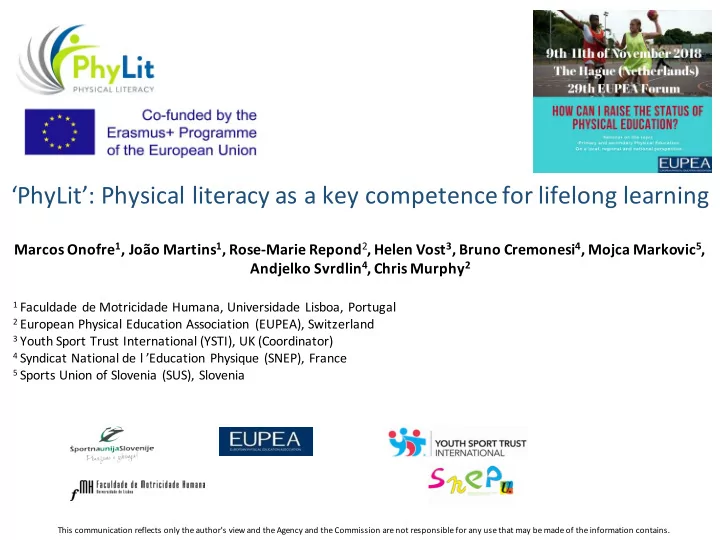

‘PhyLit’: Physical literacy as a key competence for lifelong learning Marcos Onofre 1 , João Martins 1 , Rose-Marie Repond 2 , Helen Vost 3 , Bruno Cremonesi 4 , Mojca Markovic 5 , Andjelko Svrdlin 4 , Chris Murphy 2 1 Faculdade de Motricidade Humana, Universidade Lisboa, Portugal 2 European Physical Education Association (EUPEA), Switzerland 3 Youth Sport Trust International (YSTI), UK (Coordinator) 4 Syndicat National de l ’Education Physique (SNEP), France 5 Sports Union of Slovenia (SUS), Slovenia This communication reflects only the author's view and the Agency and the Commission are not responsible for any use that may be made of the information contains.
‘PhyLit’ Team! 2 nd meeting, April 2018, Paris Kick-off meeting, January 2018, Lisbon 3 rd meeting, June 2018, Lubljiana. 4 th meeting, October 2018, London
Aim of the ‘PhyLit’ Project To introduce the Physical Literacy as key competency of the European Council Framework for Key Competences for Lifelong Learning.
Framework • The European Commission is updating and developing the 2006 framework of Key Competences for Lifelong Learning. 1. Communication in the mother tongue 2. Communication in foreign languages 3. Mathematical competence and basic competences in science and technology 4. Digital competence 5. Learning to learn 6. Social and civic competences 7. Sense of initiative and entrepreneurship 8. Cultural awareness and expression. THE OECD launched a work for 2030, ‘ The future we want: • Competencies to shape the future’, which considers the content of learning as literacy and numeracy.
Framework • UNESCO (2004) identifies Literacy as being more than just reading and writing. • … Numeracy, digital literacy, health literacy.. . WHAT ELSE?
Framework Physical Literacy as “the motivation, confidence, physical competence, • knowledge and understanding to value and take responsibility for engagement in physical activities for life ” (IPLA, 2017). The updating and development of the Key Competences Framework is the • opportunityto include newCompetences, as Physical Literacy .
Aims 1. Build an evidence-base and advocacy materials to influence policy makers to consider a key competency for Physical Literacy in the Lifelong LearningFrameworkof the European Council. 2. Build and test a self-assessment tool to support practitioners in reflecting on their current practice in providing a high quality Physical Literacy offer. 3. To identify best practice guidance to support practitioners in improvingtheir current practice and its impact on young people.
Innovative aspects • At a policy level 1. Produce advocacy materials to influence policy makers to consider a key competency for Physical Literacy in the Lifelong Learning Framework. • At an implementation level 2. Prepare and pilot a self-assessment tool with practitioners from partner countries. 3. Produce best practice guidance for practitioners in physical education, school sport and physical activity settings.
Project design and implementation – Phase I • Literature reviews 1. EU and other national/international policies on skills for lifelong learning and on Physical Literac y. 2. International approaches to the definition and description of the components of Physical Literacy. 3. Approaches to the incorporation of Physical Literacy into physical education curricula, sport programmes and physical activity initiatives.
Project design and implementation – Phase I • Literature reviews 1. EU and other national/international policies on skills for lifelong learning and on Physical Literac y. 2. International approaches to the definition and description of the components of Physical Literacy. 3. Approaches to the incorporation of Physical Literacy into physical education curricula, sport programmes and physical activity initiatives.
Project design and implementation – Phase I • Literature reviews on the PL construct Australian Sport Comission Australian Physical Literacy Standard
Project design and implementation – Phase II • Self-assessment tool 1. PL self-assessment questionnaire • Tools to identify good practices 2. PL curriculum questionnaire 3. PL coaches and teachers’ questionnaire
Project design and implementation – Phase III As for the definition of Physical Literacy as key competency Using information gathered from literature reviews and feedback from piloting of self-assessment tool to produce a definitive description of the components of the Physical Literacy as a Key Competency: - Text on politicalorientations review - Text on PL construct literature review
Conclusion… Expectations • Increase awareness and understanding of the value of Physical Literacy as a key component of a rounded education. • Highlight effective methods of using physical education, physical activity and sport as a means of developingPL. • Working to influence European policy on the adoption of a Physical Literacy Key Competency.
Li Links for online questionnaires PLSAQ - https://www.1ka.si/a/183358 PLCQ - https://www.1ka.si/a/186784 PLCTQ - https://www.1ka.si/a/188311
As Asses essmen ent of Ques estionnaire Dificulties Suggestions Layout Content
monofre@fmh.ulisboa.pt
‘PhyLit’: Physical literacy as a key competence for lifelong learning THANK YOU This communication reflects only the author's view and the Agency and the Commission are not responsible for any use that may be made of the information contains.
Recommend
More recommend